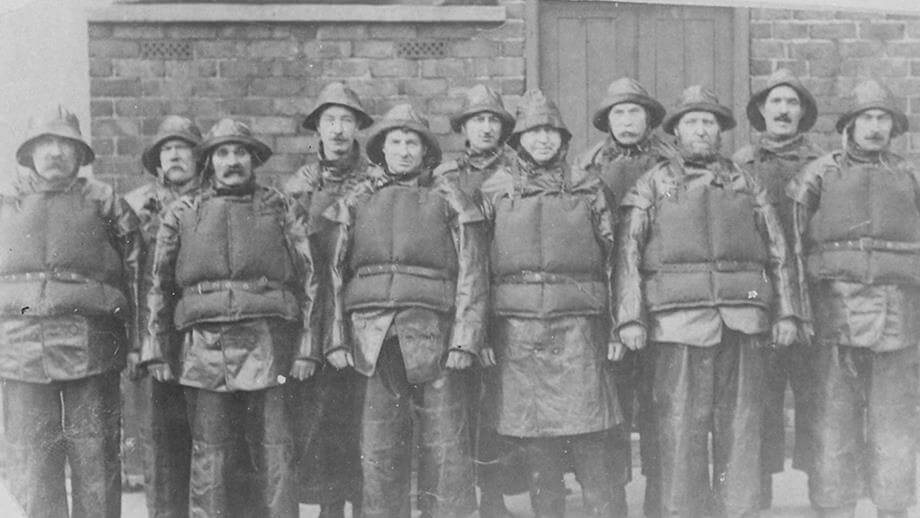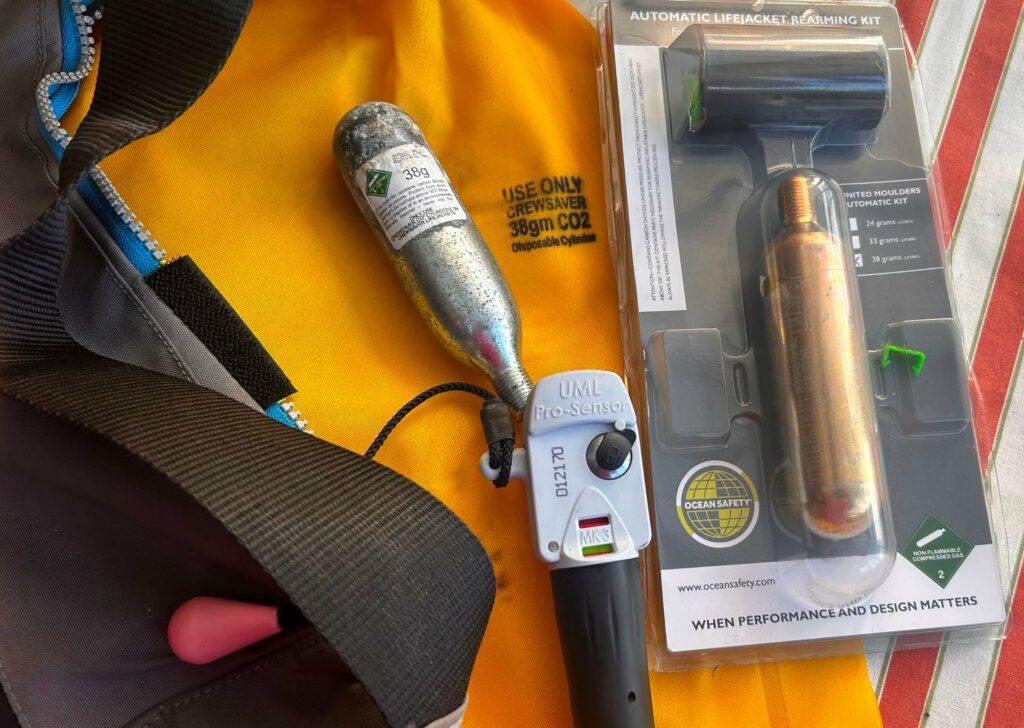
- Blog
-
by Pete Green
Introduction
Lifejackets are a key item in most modern sailors’ kit bags but most of us don’t think too hard about how these devices have developed over time. Lots of materials have been trialled over the years for their qualities of buoyancy and durability from horsehair and rushes (not too successful) to cork, balsa, kapok, foam, and from rubber to polyurethane-coated nylon. The basic purpose of the lifejacket though has always remained the same: to keep you afloat and your nose above water. This article explores the timeline of lifejacket development from 870BC to the present day. It concludes with a summary of how to do a pre-season check on your lifejackets integrity and buoyancy and how to rearm it with a new gas canister.
From animal bladders to gas cylinders
870 B.C. The earliest example of a lifejacket or flotation device being used can be found on a marble carving in the British Museum. This shows Assyrian soldiers swimming while holding on to inflated animal skins. Other first examples include people using hollow sealed fruit as an aid when crossing deep streams and Norwegian sailors using simple blocks of buoyant wood and cork.
1757. Colonel de Gelacy, a Frenchman is reputed to have devised the first cork life preserver
1765. Dr John Wilkinson patented the first cork life jacket.

1805. At the Battle of Trafalgar, lifejackets were non-existent. Sailors had to cling onto flotsam and jetsam until rescued. During this period the drowning of sailors and fishermen was thought to be an occupational hazard. Lifejackets were not part of the equipment given to naval sailors until the early 19th century.
1851 – 54. Captain John Ross Ward, a RNLI Inspector, is credited with developing the first lifejacket made out of cork for the Royal National Lifeboat Institution crews.
It was around this time that the number of deaths by drowning among professional sailors increased, this was part due to wooden boats being replaced by iron ones that did not have spars, masts and other floating wooden debris around for sailors to hold onto if they found themselves in the water.
1852. US Congress passed the first requirement that passenger steamboats on the nation’s rivers carry a float or life preserver for every passenger.
1861. Cork became the main material in all lifejackets and was used for many years despite by rather hard and uncomfortable to wear.
1896. Kapok became the standard life-jacket stuffing around the turn of the century, this is a vegetable material honeycombed with air cells. The cottony material was full of hair-like follicles that contain natural oils which are non-absorbent to water and the air within them gives the material very high buoyancy. The kapok fibre was sealed in canvas and later vinyl plastic packets to prevent exposure to the water. Kapok was a much softer alternative to cork and so it was particularly practical on large navy ships where the sailors often slept in their life jackets.

Early 1900s. Rubber and batteries were used in life vests for inflation and lighting. These lifejackets were able to send and receive SOS messages.
1912. The sinking of the SS Titanic prompted many countries to adopt laws requiring ships to carry lifejackets for all crew and passengers.
1913. The first International Convention for the Safety of Life at Sea (SOLAS) was held.
1928. The SOLAS Committee used a mannequin to investigate the performance of a lifejacket and protective oilskins on turbulent seas.
1929. There was an investigation into the shortfalls of some lifejackets. The main problem was that the wearer was often left floating face down in the water.
1939 – 45. Further improvements to lifejacket design happened after losses in the Battle of Britain during World War II, with developments coming from both sides of the conflict. Dr. Edgar Pask, a physician who worked for the RAF pioneered the use of a hybrid inflatable/inherent buoyancy jacket called the Mae West with UK pilots. On the German side, scientists working for the Luftwaffe responded to pilot loss in the North Sea by also developing inflatable lifejackets. Unfortunately many Royal Navy sailors drowned as a personal issue lifejacket did not exist.

1956. Rescuers from the Andrea Doria disaster noted that survivors wearing lifejackets made of yellow fabric were much easier to spot in the water than camouflaged gear. This led to fabrics being dyed bright colours ranging from canary yellow, international orange to scarlet.
1960s. Synthetic Foam began to replace kapok because of its inherently buoyant qualities and added flexibility which allowed it to be made into a comfortable tight fitting vest. The RNLI developed The Beaufort lifejacket, the buoyancy of the foam meant the lifejacket could support both the wearer and the casualty and ensured that crew floated face upwards in the water if they were knocked unconscious.
1970s. Closed-cell foam began to be used in lifejackets. The large number of isolated air filled cells provided the flotation which could be punctured over and over again with only minimal effect on buoyancy whilst also providing protection from hypothermia.
2000s. Increased popularity of automatic gas inflated life jackets, especially for recreation. The designs are increasingly becoming more personalised, specialised and tailored towards a wide range of watersports.
How do automatic lifejackets work?
Automatic lifejackets have a trigger mechanism inside them located in the plastic tube that is screwed onto the gas cylinder. This trigger mechanism is a small tablet that dissolves in water when the lifejacket is immersed; the absence of the tablet allows a spring to activate a pin which pierces the gas cylinder so CO2 gas can escape into the sealed air bladder. The bladder can be self-inflated by pulling a cord on the lifejacket and topped up with air manually by blowing into a tube that has a one-way valve.
Pre-season lifejacket checks and how to rearm a lifejacket
Many lifejacket manufactures recommend that you get your LJ serviced professionally each year. It is possible to rearm your gear at home though; here is how to do it.
- Undo your LJ and visually inspect the gas canister, a new one is definitely required if the old canister shows signs of corrosion, is damaged or out of date. The date will be written on the old canister or on the bladder along with the gas cylinders size (they vary). New rearming kits can be bought from larger chandlers.
- You can also check the status of your automatic trigger mechanism by looking through the visual inspection window. If it is green the mechanism is in good order, if it is red, the LJ needs to be rearmed.

- Then repack your LJ’s bladder into the outershell and inflate it by pulling the toggle. Leave it inflated overnight; if the bladder is intact it should still be firm in the morning. Look carefully for any holes near to the seams and on the folds and creases. If there is a hole, throw the LJ away, don’t be tempted to repair it with a puncture repair kit!
- Deflate the bladder by pushing down on the red manual inflation tube and squeezing the air out.
- Take you new rearming kit and unscrew the black tube from the LJ and replace it with the new one.
- Carefully insert the green plastic clip into the yellow bobbin, this holds the firing pin in place.
- Finally unscrew the old gas canister and replace with the new one. It needs to be in securely but not overtightened.
- Pack up the bladder and zip back into the outer shell. Check that the automatic trigger mechanism is green.
A good place to find additional information is on the RNLI’s website https://rnli.org/safety/lifejackets

With highly qualified and experienced crew, Halcyon Yachts Ltd offers a dedicated international yacht delivery service. For more information or to see details of their recent deliveries please visit: https://halcyonyachts.com/



